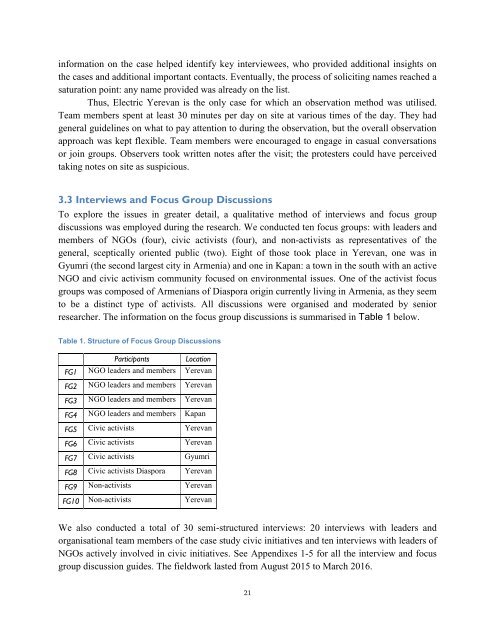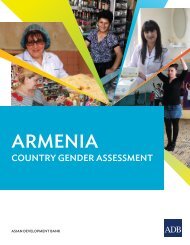Civic Activism as a Novel Component of Armenian Civil Society
English-3
English-3
You also want an ePaper? Increase the reach of your titles
YUMPU automatically turns print PDFs into web optimized ePapers that Google loves.
information on the c<strong>as</strong>e helped identify key interviewees, who provided additional insights on<br />
the c<strong>as</strong>es and additional important contacts. Eventually, the process <strong>of</strong> soliciting names reached a<br />
saturation point: any name provided w<strong>as</strong> already on the list.<br />
Thus, Electric Yerevan is the only c<strong>as</strong>e for which an observation method w<strong>as</strong> utilised.<br />
Team members spent at le<strong>as</strong>t 30 minutes per day on site at various times <strong>of</strong> the day. They had<br />
general guidelines on what to pay attention to during the observation, but the overall observation<br />
approach w<strong>as</strong> kept flexible. Team members were encouraged to engage in c<strong>as</strong>ual conversations<br />
or join groups. Observers took written notes after the visit; the protesters could have perceived<br />
taking notes on site <strong>as</strong> suspicious.<br />
3.3 Interviews and Focus Group Discussions<br />
To explore the issues in greater detail, a qualitative method <strong>of</strong> interviews and focus group<br />
discussions w<strong>as</strong> employed during the research. We conducted ten focus groups: with leaders and<br />
members <strong>of</strong> NGOs (four), civic activists (four), and non-activists <strong>as</strong> representatives <strong>of</strong> the<br />
general, sceptically oriented public (two). Eight <strong>of</strong> those took place in Yerevan, one w<strong>as</strong> in<br />
Gyumri (the second largest city in Armenia) and one in Kapan: a town in the south with an active<br />
NGO and civic activism community focused on environmental issues. One <strong>of</strong> the activist focus<br />
groups w<strong>as</strong> composed <strong>of</strong> <strong>Armenian</strong>s <strong>of</strong> Di<strong>as</strong>pora origin currently living in Armenia, <strong>as</strong> they seem<br />
to be a distinct type <strong>of</strong> activists. All discussions were organised and moderated by senior<br />
researcher. The information on the focus group discussions is summarised in Table 1 below.<br />
Table 1. Structure <strong>of</strong> Focus Group Discussions<br />
Participants Location<br />
FG1 NGO leaders and members Yerevan<br />
FG2 NGO leaders and members Yerevan<br />
FG3 NGO leaders and members Yerevan<br />
FG4 NGO leaders and members Kapan<br />
FG5 <strong>Civic</strong> activists Yerevan<br />
FG6 <strong>Civic</strong> activists Yerevan<br />
FG7 <strong>Civic</strong> activists Gyumri<br />
FG8 <strong>Civic</strong> activists Di<strong>as</strong>pora Yerevan<br />
FG9 Non-activists Yerevan<br />
FG10 Non-activists Yerevan<br />
We also conducted a total <strong>of</strong> 30 semi-structured interviews: 20 interviews with leaders and<br />
organisational team members <strong>of</strong> the c<strong>as</strong>e study civic initiatives and ten interviews with leaders <strong>of</strong><br />
NGOs actively involved in civic initiatives. See Appendixes 1-5 for all the interview and focus<br />
group discussion guides. The fieldwork l<strong>as</strong>ted from August 2015 to March 2016.<br />
21



